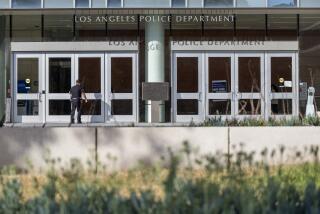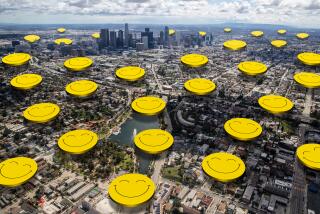Should cyclists yield at stop signs? Riders and motorists weigh in.
- Share via
I’m used to reading nasty messages after I post on The Times Opinion blog. The comments section often draws angry people — or in any case, people who vehemently disagree with me. When I posted about bicycle laws a couple of weeks ago as part of our Roadshare project, a commenter noted that “this article ranks among the dumbest I’ve read on the subject.”
That struck me as strong language; surely he’d read many dumber things than my post. I know I have.
But my point is not to complain. Rather, it’s to say that my most recent post — on whether cyclists should be allowed to treat stop signs as yield signs as the law allows in Idaho (i.e., slow down and be careful but don’t necessarily stop) and to treat red lights as stop signs (i.e., stop but then go even before the light turns green if the coast is clear) — received a more polite batch of comments than usual.
I expected vituperative remarks, especially from drivers who would vow to run down any bicyclist who dared to ignore a stop sign or red light. (And there were a few of those.) But for the most part, the responses were thoughtful and articulate.
FULL COVERAGE: Sharing the road in L.A.
For instance, there was “burntorange,” who wrote:
“The amount of effort required for me to stop at a stop sign on my bike is far beyond reasonable. The amount of effort required to stop at a stop sign in my car is zero.... It is absolutely absurd for cycists to stop and drop a foot only to have to then immediately start pedaling again from a dead stop. The closest equivalent I can think of for drivers would be a requirement that they come to a complete stop, shift into park, and step out of the vehicle to check all of their blind spots.”
Others complained, however, that if bicyclists were told they could yield at stop signs rather than make a full stop, they would take it a step further and simply roll right through the signs. “CarlosE” wrote that “the only part people will hear is that they don’t have to stop at red lights or stop signs.” That started a bit of a conversation.
“burntorange”: “Its called yielding dude. No one said anything about ignoring stop signs.”
“surf city rod”: “Why do you think that if cyclists won’t stop for stop signs they are going to yield for stop signs?”
“edwardskizer”: “OK, so long as a motor vehicle driver is exempt from a lawsuit or criminal charges if he plows into a bicyclist running a red light or stop sign. Oh, and the cyclist may be held liable for any damage to the lawfully moving vehicle.”
“FusoRider”: “I have been riding my bike around L.A. for almost 20 years and, like Nicholas Goldberg, I rarely come to a full stop at stop signs. But I always slow down and prepare to yield if necessary. The key is communication with the motorists at the intersection. I let them know, as I’m slowing down, that I’ll wait for them to go through, or I give them a thank-you wave and smile if they indicate I should go ahead. A law like Idaho’s sounds like a good thing that motorists can learn — just as California’s rules for yielding to pedestrians in crosswalks is more strict than other states, but it works.... On my bike I always stop for red lights, but will often start up just before the light turns green so that I have established my place on the road by the time the cars start moving — it’s safer for me to get up to speed first and motorists seem to appreciate the predictability of where I’m going to be. I would propose that, as Los Angeles develops its master bike plan, consideration be given to outfitting intersections on key cycling routes with traffic lights that give a green light to bicycles first — 5 to 10 seconds? — followed by the green light for cars.”
“FusoRider’s” comments struck me as highly reasonable. But so did “Ennyone’s”, on the pro-vehicle side:
“The issue is speed. Cyclists move just as fast as most cars in the city (sometimes faster) and therefore present a sudden and often unavoidable hazard when they pop out from stop signs or red lights when through-traffic expects other vehicles not to be there. Leaving the decision to stop up to the cyclists is as dangerous as leaving it to motorists. Traffic controls are there to reduce congestion and minimize accidents because we humans frequently don’t see traffic that is plainly there, and sometimes even fail to notice the traffic signals and signs themselves. If you want to avoid stopping for stop signs, get off the bike and walk it across the intersection like a real pedestrian. As a side note, however, drivers need to chill out on message boards.”
I liked the suggestion about chilling out on message boards. Because there were definitely some hostile comments.
For instance, “daniel160” said: “I think cyclists need to wake up to the fact that they are really starting to irritate a LOT of people. They are always whining about how they are disrespected on the road and yet so many of them have no respect for drivers or the laws of the road that keep things civil and working. I pulled up to a busy four-way stop tonight. I patiently waited for my turn, then started into the intersection. I had to slam on the breaks because a swam of bikes coming from both directions flew through the intersection, completely ignoring the stop signs. Everybody I talk to lately says how much they hate cyclists because they are rude and dangerous. We have to work together on this. One place to start is by EVERYBODY obeying the traffic laws. If things continue as they are I see a big battle brewing and cyclists are far outnumbered at this point.”
And this one from “No Buey Jose” was obnoxious, but it made me laugh: “Cyclists should definitely be exempt from stop signs. In fact, they should be exempt from all provisions of the California Vehicle Code. Then just let things take their natural course.”
Just to be clear: That’s not a good idea.
ALSO:
The trouble with Angels Flight
Chipping away at Obamacare: The endgame in D.C.
Tea party wants to take America back -- to the 18th century
More to Read
A cure for the common opinion
Get thought-provoking perspectives with our weekly newsletter.
You may occasionally receive promotional content from the Los Angeles Times.











